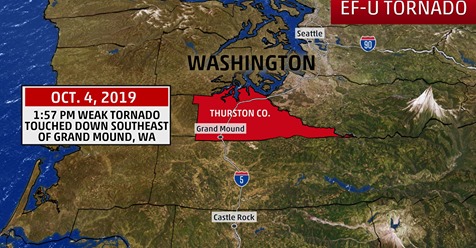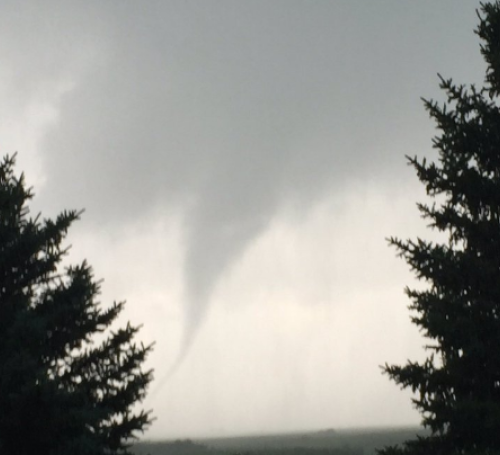OUTING, Minn. — Exactly 50 years to the day that a deadly tornado swept through northern Minnesota, many of the survivors and first responders were among the more than 250 people who gathered at Luscher’s Park in downtown Outing on Tuesday, Aug. 6, to reflect on the tragedy that changed their lives forever.
A “Winds of Remembrance” tribute at the park marked the 50th anniversary of the F4 tornado that killed 12 people near that small community about 42 miles north of Brainerd. It was part of a series of tornadoes that took a total of 15 lives across northern Minnesota that day.
The event, which included a dedication of two granite park benches with plaques featuring the names of the Outing tornado victims, was a day for survivors to finally meet with the first responders and area residents who helped out after the storm hit around 5 p.m. on Aug. 6, 1969.
One survivor, Priscilla Dugan, spoke at the gathering and thanked the community for their generosity — especially law enforcement, the hospital staff in Crosby and the many volunteers.
“Many of the survivors didn’t have anything — just the clothes on our backs,” she said, “but the people of Outing took us in. They fed us and helped us find clothing. They took care of us.”
Dugan and her niece, Sue Moline, were among a handful of survivors who returned for the anniversary tribute.
“This has been a beautiful day, and the support has been incredible,” Moline said. “We were visitors here, and we all went home. But the people in this community continued to work around the clock to rebuild. Many people didn’t understand the impact that (the storm) had on this part of the state.”
A total of 11 people died near Roosevelt Lake, and another victim, 2-year-old Susan Marko, died at nearby Reservoir Lake.
“There’s been a hole in our lives for 50 years,” said survivor Jeanne Marko, Susan’s older sister.
For decades, many of the survivors didn’t talk about that tragic day. But that began to change in the past year when Moline solicited discussion from survivors and witnesses through news media coverage.
“I’ve had responses from 130 people,” said Moline, who shared some of the stories of survival. “We’ve learned a lot, but my research still leaves a lot of questions about that day. I figured that if I didn’t start asking people questions, there will be no one left to ask.”
Moline even talked with the National Weather Service staff in Duluth.
“I also wanted to know what they knew about the storm,” she said. “And they said they haven’t studied too many F4 tornadoes that cut across water. I could never figure out how we ended up in the lake, but ending up in the water probably saved our lives.”
One of the most amazing stories told at the tribute referred to witnesses seeing the bottom of Roosevelt Lake appear as the tornado crossed over the water. After the storm, there were reports of fish being carried as much as 35 feet up the hill around the lake.
The movement of water also sucked the lakeside cabin that Dugan and Moline had taken cover in. The cabin, owned by Bethany Fellowship of Bloomington, was lifted off its foundation and carried into the lake, and four of the 17 people in the cabin did not survive.
“We had no warning,” Moline said. “I remember looking out the (cabin) window that faced the lake when a neighbor came running in, and told us that a tornado was coming.”
A few seconds later, the tornado picked up the one-level cabin and carried it into the lake.
“It lifted our cabin right off the foundation,” she said. “It was like the rug was pulled out from under us and we were in a washing machine. I was underwater and unable to breathe. I thought I was going to die. I was gasping for air when I surfaced in 5-foot waves about 300 feet from shore. I didn’t see another person at first, but then people started popping up.”
Moline eventually made it back to shore, but three members of her family drowned, including her 19-year old sister, her grandma and her 5-year-old cousin.
“A total of seven people that I knew had died,” Moline said. “Other people that we knew from (Bethany Fellowship) were there that day, plus my two uncles’ families were there. It was like a Dugan family reunion.”
Five days after the storm, Moline and her family returned to Bloomington for a seven-casket funeral.
One of the people who Moline was especially appreciative of was Brainerd scuba diver Bill Matthies, who recovered the bodies of two of Moline’s family members from Roosevelt Lake. After initial efforts to locate the victims failed, Matthies was called in two days later to locate the final two bodies — 13-year-old Paul Brokke and Dugan’s 5-year-old daughter Sharon — who were swept into the lake by the storm.
“How could we have gone back to our (South Dakota) home if we didn’t know where our daughter was?” Dugan said. “(Matthies) was an angel for us.”
One of the storm workers who attended Tuesday’s tribute was George Carleton, who currently lives in Merrifield. Carleton recalls being near Crosslake in 1969 when he first spotted the storm passing through the Outing area.
“That was the biggest thunderhead I’ve ever seen,” he said. “The fire trucks were flying through Emily, so I knew it was bad. I grabbed my chainsaw and gas and drove to Outing. A deputy stopped me, and I told him that I had a chainsaw. He told me to get to Hilltop (road) and help clear room so the ambulance could get to (the Bethany Fellowship property). We slept for about an hour that night, and then went across (Roosevelt Lake) to cut up cabins and help look for two missing people at (the former) Simmons Resort.”
by Pete Mohs (2019, Aug 7) Grand Forks Herald



